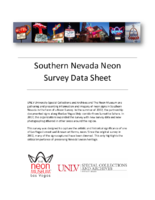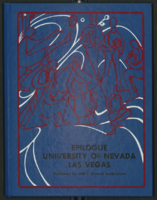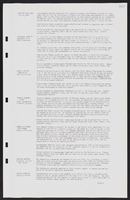Search the Special Collections and Archives Portal
Search Results

High Hat Regency Neon Survey document, September 6, 2017
Date
Archival Collection
Description
Site address: 1300 S Las Vegas Blvd
Sign owner: Tarighi Bahman and Farideh
Sign details: The building was constructed in 1958 (Assessor). A vintage postcard from the 1950's-- or more likely the 1960's (based upon the automobiles pictured)-- shows that the business was previously named the Chevron Motel (Las Vegas motels then and now).
Sign condition: Condition is 3-4, fair to good. The pole, cabinets and reader board are in good condition. Moderate rust is evident around the edges of the top cabinet. The paint is generally in good condition, although there white patches (from repairs?) on the chevron. The neon tubing is entirely intact. Most of the incandescent light bulbs are present, except for the underside of the lower cabinet, where they are completely absent.
Sign form: Pole Sign
Sign-specific description: A single round white metal pole supports the sign, which is cantilevered toward the street. The cabinets form a rectangular "C" which is open on the motel side. The interior of the "C" surrounds a chevron which points toward the motel. On top of the motel side of the upper cabinet is a metal top hat and cane. The sign is attached to the pole at the side of the lower cabinet, the point of the chevron and the bottom of the upper cabinet. The background color of the sign is sky blue. The bottom of the face of the lower cabinet has the word "VACANCY" painted in white sans serif letters. The letters are traced in white skeleton neon. To the left, the word "NO" is spelled out in clear skeleton neon sans serif letters. Above the neon letters is a white metal reader board which has a row of clear incandescent light bulbs running along the top, bottom and motel side edges. A single row of clear incandescent light bulbs runs the entire length of the street side of the sign. On the street side of the chevron is a blue metal cabinet with the word "MOTEL" spelled in white channel letters. The channels are outlined by white neon tubes, while the interior of the channels are filled with clear or white incandescent light bulbs. On the motel side of the "MOTEL" cabinet is a blue chevron which is covered with clear or white incandescent light bulbs. The top cabinet features the words "High Hat" spelled out in white cursive letters. Below is the word "REGENCY" painted in white sans serif letters. All wording is traced by white skeleton neon. On top of the motel side of the upper cabinet is a white top hat with a blue hat band. Running through the hat is a white cane. The hat and cane are traced by white skeleton neon. The hat is covered with white or clear incandescent light bulbs.
Sign - type of display: Neon, incandescent, reader board
Sign - media: Steel, plastic
Sign - non-neon treatments: reader board
Sign animation: Light bulbs flicker
Sign environment: Las Vegas Boulevard South, north of the Las Vegas Strip near other motels and wedding chapels.
Sign - date of installation: c.1950s
Sign - thematic influences: Elegance, sophistication, high society, boomerang/chevron, 1950's, 1960's, mid-century
Survey - research locations: Assessor's website
Survey - research notes: Connolly, D. (2012 July 21). Chevron Motel. Retrieved from https://www.flickr.com/photos/dennisconnolly5059yahoocom/7635650456 Hagopian, M. (2011 January 28). No vacancy in vintage Vegas. Retrieved https://hyperallergic.com/15738/no-vacancy- vintage-vegas/ Las Vegas motels then and now. (n.d.). Chevron Motel. Retrieved from http://stefanidrivesvegas.com/8.html RoadsideArchitecture. (n.d.). High Hat Regency Motel. Retrieved from http://www.roadarch.com/signs/nvvegas.html Seltzer, D. J. (2014 June 1). High Hat Regency Motel sign in Las Vegas [Video recording]. Retrieved from https://www.youtube.com/watch?v=-bQdw48LVrA
Survey - other remarks: A vintage postcard circa 1950's-1960's shows the Chevron Motel sign as a simple pole mounted with a reader board and two light boxes which form a "C" shape open toward the motel (Las Vegas motels then and now, n.d.). A later postcard features the same sign with a chevron in the center and a semi-circular arch which encloses a light ball above the upper cabinet (Connolly, 2012). The current sign retains the chevron, the metal frames of the light boxes and reader board (Las Vegas motels then and now, n.d.). A hat and cane have replaced the arch and light ball at the top of the sign (Las Vegas motels then and now, n.d.). The light boxes have been replaced with metal cabinets with incandescent and neon displays (Las Vegas motels then and now, n.d.). The sign is pictured in a vintage postcard circa 1950's-1960's (Las Vegas motels then and now, n.d.). At that time it advertised the Chevron Motel.
Surveyor: Mitchell Cohen
Survey - date completed: 2017-09-06
Sign keywords: Neon; Incandescent; Steel; Plastic; Reader board; Pole sign; Flickering
Text
Junior League of Las Vegas Records
Identifier
Abstract
The Junior League of Las Vegas Records (1940-2023) contain annual reports, fundraising information, training manuals, articles, minutes, photographs, scrapbooks, cookbooks, and other operational and working files that document the activities of the Junior League of Las Vegas (JLLV). Also included is documentation for advocacy projects the JLLV was involved with, such as Drug Abuse Resistance Education (D.A.R.E.), Safe Haven, the Ronald McDonald House, Read Aloud, and Literature Awareness Program for Children. Other records in this collection document JLLV's fundraising efforts such as the Repeat Boutique, Holiday Coffees, annual benefits, luncheons, and sales of their cookbooks. Also included are scrapbooks and issues of their newsletter
Archival Collection
Robert Woodruff Papers
Identifier
Abstract
The Robert Woodruff Papers (1927-2001) are comprised of materials documenting Woodruff’s career and family life in Las Vegas and Henderson, Nevada, as well as his travels around the United States and abroad. Materials include newspaper clippings, photographic prints and transparencies, personal correspondence, and publications such as Las Vegas tourist brochures and pamphlets dating from the 1930s and 1940s. Visual materials include portraits, city scenes, and landscapes throughout Nevada and the United States, as well as some photographs of international travels.
Archival Collection
Dunes Hotel and Casino Records
Identifier
Abstract
The Dunes Hotel and Casino Records are comprised of administrative, publicity, and entertainment materials documenting the history of the Dunes Hotel and Casino in Las Vegas, Nevada from the years 1954 to 1992. Included are correspondence, contracts, photographs, hotel budgets, and an early aerial photograph of the property. The material provides a significant amount of historical documentation of the hotel that was long known to tourists and residents as the "the Miracle in the Desert."
Archival Collection
Wengert Family Papers
Identifier
Abstract
The Wengert Family Papers (approximately 1900-2000) consist of scrapbooks, newspaper clippings, correspondence, postcards, photographs, and other documents from members of the Wengert family. The Wengert family were members of the Las Vegas, Nevada community since 1907. The collection contains items detailing Lottie Ward Wengert’s life in Iowa before she moved to Las Vegas, Nevada, such as high school and college documents and diplomas, as well as programs and invitations for events in Iowa, Las Vegas, and other cities. The materials regarding Cyril S. Wengert are mostly newspaper clippings about his accomplishments and articles and cards expressing sympathy after his death. Other items include documents from the U-Wah-Un Study Club, of which Shirley Wengert was a member.
Archival Collection

Epilogue: UNLV Yearbook, 1976
Date
Description
Yearbook main highlights: schools and departments; detailed lists with names and headshots of faculty, administration and students; variety of photos from activities, festivals, campus life, and buildings; campus organizations such as sororities, fraternities and councils; beauty contest winners; college sports and featured athletes; and printed advertisements of local businesses; Institution name: University of Nevada, Las Vegas
Mixed Content

Jamey Stillings Artist Statement: "Changing Perspectives: The Evolution of Ivanpah Solar," 2015
Date
Archival Collection
Description
Text

Photographs of Imperial Palace signs, Las Vegas (Nev.), 2002
Date
Archival Collection
Description
Nighttime views of the Imperial Palace Hotel and Casino signs on the Strip. Information about the sign is available in the Southern Nevada Neon Survey Data Sheet.
Site address: 3535 S Las Vegas Blvd
Sign owner: Ralph Engelstad
Sign details: Shadowing Oshea's, the Imperial palace looms high above the street. The tower for the hotel is located just east of the strip, but one of the main entrances is the unique porte-cochere and facade on the east side of the strip. The main tower resides east, seen behind the Harrah's Carnival Court. Signage includes Giant channel letters on the tower, five cabinets of the Imperial Palace logo initials placed along the towers, internally lit sculpted cabinets on the front tower, as well as the an LED screen, and a vastly lit porte- cochere, along with cabinets.
Sign condition: Structure 4 Surface 3 Lighting 4 The structure of the Imperial Palace's main tower signs seem to be intact, while the front towers signage and porte cochere are in great repair. The surfaces of the main tower are rather dull and pale during the day, but the light color aids in the luminescence at night. The lighting is in excellent repair.
Sign form: Fascia; Porte-cochère
Sign-specific description: The structure is themed after an Asian palace, complete with multi tiered swooping tiled Asian style roof lines, and wooden square beams placed to be representative of rice paper doors and windows, and symbols of dragons. Between two gaping square entrances of the front tower, sliding doors almost cower below a giant color LED message center, flanked by two back-lit , color, flex-front, two-dimensional dragons. The dragons stand upright pawing at each side of the central cabinet. The entire array sits on the lowest swooping Asian design roof level in blue tiles. As the building rises upwards, the center section repeats in multi tiered, blue roof lines, finally crowning with a fourth one, peaked at the top. The bottoms of each ones of these rooflines is bordered on the bottom with blue tubes of neon. The two main drives into to covered porte cochere, head east then turn inward, forming a squared U shape. Obviously one door is for entrance and one an exit. The ceiling is comprised of polished aluminum square panels, each one with four large, spherical, incandescent bulbs. The effect is an engaging field of animated bulbs, interrupted only by the presence of five large circular cabinets, which hang facing the floor. One hangs just into the entrance and exit, and one in the center of the north/south connecting sections of the two flanking tunnels, and two more set in the corners. The two just into the mouth, and in the corner of the tunnels, are polished aluminum themselves, with internally lit plastic fronts. These fronts are blue and white, pained graphically with an Asian geometric design, which fills the entire surface. The one cabinet is treated in the same exterior finish, but the design is created out of blue neon. Above the doors to the casino, in this cove, polished channel letters with blue plastic fronts, and borders created with narrow channels, are lined with incandescent bulbs. The tower set back into the property is adorned by a set of two story tall, white channel letters, facing west just below a long blue tiled roof, spell "Imperial Palace" and are filled with blue neon. Letters can be seen on the East face of the tower as well. On the same level of the southern end of the tower, a square, blue, channel edged cabinet, holds the channel letter initials "I" and "P." Another cabinet faces north on the north side of the tower. The channels and initials are lined with blue neon. The same arrangement can be found on the east side of the tower as well. The I and P can also be seen on the north and south end of the tower, but without the border. All of the rooflines on the tower are lined with blue neon as well. Both towers are ambiently lit with blue spotlights, casting a blue hue all over the property. At the very top of the front tower, a spike rises into the air, and is adorned with rings of blue neon.
Sign - type of display: Neon; Incandescent; Backlit
Sign - media: Steel; Plastic
Sign - non-neon treatments: Graphics
Sign animation: Oscillating
Notes: The incandescent bulbs covering the ceiling of the porte cochere, oscillate vibrantly, creating a shimmering cave of light.
Sign environment: The Imperial Palace is placed in an unusual position, with the front tower pushed right up to the street, with cars and taxis zipping in and out of the large square entrances. Just to the north is the Harrah's Carnival Court, which pushes right up to the edge of the north face of the front tower. Just to the south O Shea's sits in the great blue shadow of the Imperial palace.
Sign - date of installation: The hotel opened as the Imperial Palace in 1979. The front tower was built in 1981. The hotel was finished in three phases 1981, 1982, and 1987-1989.
Sign - thematic influences: The Imperial Palace is themed after an Asian palace, signifying the theme through several structural elements seen on the exterior. The stylized roofline, and actual shape of the roof are the representative of the classic eastern palace design seen throughout most Asian cultures in their history. The text on the main towers is stylized and representative of western text written to resemble the graceful brush stroke of Asian characters. Another obvious aspect is the backlit Asian dragons on either side of the giant LED screen on the front of the tower containing the porte-cochere. The Imperial Palace is a themed hotel, revolving around a culture, like that seen in Paris or the Bellagio. The significance of the signage relies in its Porte cochere. Related to the Riviera's parking garage due to the fact that it is located inside of one of the buildings, hidden away from plain sight. The stunning array of incandescent bulbs, lining the ceiling, and reflecting off of the high use of reflective panels. The use of the reflective metals is evidence of the leftover trend massive trend used in the 1970's due to an energy shortage. It itself, is a one of a kind porte-cochere and, is one of the most vibrant still in existence.
Surveyor: Joshua Cannaday
Survey - date completed: 2002
Sign keywords: Oscillating; Fascia; Porte-cochère; Neon; Incandescent; Backlit; Steel; Plastic; Graphics
Mixed Content

Photographs of Luxor signs, Las Vegas (Nev.), 2002
Date
Archival Collection
Description
Site name: Luxor (Las Vegas, Nev.)
Site address: 3900 S Las Vegas Blvd
Sign owner: Mandalay Resort Group
Sign details: The giant black, glass, pyramid rises out of the desert as certainly one of the most unique structures. The pyramid is also accompanied by a monolithic, heavily geometric structure, finished in the same black, panels of windows. Just to the north. The front of the property is dominated by an array or Egyptian architectural landmarks such as an giant obelisk, the Sphinx, various statues of Egyptian gods and pharaohs line the multi tiered expanse of concrete and stucco. The property is pedestrian interactive, being able to pass underneath the giant obelisk, and through and beneath the giant Sphinx. The feel produced by area is appropriate for the desert environment.
Sign condition: Structure 5 Surface 5 Lighting 5
Sign form: Pylon; Fascia; Porte-cochère
Sign-specific description: On the expanse of concrete in front of Las Vegas Blvd, just north of the obelisk, a double-sided pylon sign joins the ancient composition. The pylon actually is more akin to the pylons seen at properties such as the Monte Carlo or the Mirage. It is located in the northern portion of the property on the west side of the strip-facing northwest along Las Vegas Blvd Two square posts support a two-sided square cabinet which houses a back lit advertisement and a set of crafted letters spelling the name of the establishment. Occupying the upper portion of the space between the legs another internally lit, two sided, cabinet, atop a small pair of internally lit sculpted cabinets. From a distance the cabinets look like thumbs holding up the cabinet. The shapes are graphically treated on the surfaces to look like colorful recreations of a hieroglyphic bird, the wings being the elongated portion of the cabinet. The only art attached to the cabinet is the portion designated for the head of the creature. Three sets of sculpted cornices, create borders for the different planes. The bases of the legs are treated with the ledging, the section separating the top cabinet, from the rest of the sign, and finally another set around the top crowning edge of the sign. Both sides of the top edge have a sculpted element in the very center. A flat circle, presumably a representation of the sun, flanked by two snakes are set on a pair of large wings spreading to either side. This element is ambiently lit from underneath. The text, which spells "Luxor," is composed of polished gold channel letters, with closed faces with graphic treatments in blue upon the faces. The faces are painted to appear if the letters are faceted into three dimensions. They are lit from behind with whit neon creating a halo effect around the letters. The surface of the actual structure is finished to appear as if it is constructed of limestone, utilizing false joints and seams. The south end of the property close to the street is the four-sided obelisk. The text on the obelisk is the same word treated in the same fashion, structurally and aesthetically, as the pylon sign. The only difference is that it reads vertically from top to bottom. Statuary adorn the base of the obelisk in a repeating pattern as well as it being covered in hieroglyphic patterns. A tunnel allows for the pedestrian to pass underneath the obelisk. The porte cochere is located underneath the body of the Sphinx, another use of the architecture to incorporate the pedestrian element. If you head east through the sphinx, a tunnel opens up into a small courtyard where a shuttle bus may be caught. The ceiling of the porte cochere is adorned with a circular chandelier, composed of metal representations of leafy branches radiating around a rounded center. The ends of the arms hold length-wise half cylinder lamps. The ceiling above is painted blue. The most spectacular element of the Luxor is its super powerful light in the place of the capstone at the very peak. The beam is one of the most powerful lights in the world, and can be seen from high above into the earth's atmosphere as well. The edges of the pyramid are also raceways, which can be seen in action in the dark. An animation of bulbs makes it appear as if a single bulb of light streams up the base to the very peak. The animation runs at an interval of every couple of seconds. On the very south edge of the property, actually on the southeast corner, is a sculpted, small pylon which houses a color led screen.
Sign - type of display: Neon
Sign - media: Steel; Masonry
Sign - non-neon treatments: Plaster
Sign animation: Chasing
Sign environment: Standing next to the Mandalay Bay on the west side of the southern end of Las Vegas Blvd, the Luxor's front exterior is a sprawling mass of smooth vertical planes turning into eloquent statue and stucco walls. They are interlaced with drives and signage complete with a platform at the base of the Sphinx, which is just east of where the valet and porte cochere are grounded in the base of the beasts belly. From the edge of a Platform a tram station is located and also a view of the signage can be seen as well. The Luxor's environment is a very pedestrian one as well. Being in an isolated part of the strip, the noise clutter brought about by the surging traffic is considerably better than the heart of the strip.
Sign designer: Veldon Simpson
Sign - thematic influences: The theme of the Luxor is obviously that of ancient Egypt. The Ancient Egyptian imagery is placed among the same images but represented in the shiny black glass, giving a touch of future meets the past. The image seen are some of the most commonly seen images when talking about the Ancient Egyptian culture. The Sphinx stands guard at the base of the giant black pyramid, one sign is attached to an obelisk. Various statuary adorn the entire plaza. The environment created with the motif obviously fits into the desert like dust, but still retains the surreal nature associated with the themed hotel. The aesthetics appear to be fantastic, but are a bit odd due to the arrangements and limitations on space. It does however fir into an interesting sub category of resort that is themed around a culture. Yes it is themed around a city, but the culture shines through with more dominance. Another example of this is the Imperial Palace. It is not necessarily themed after a particular city, but the architecture and imagery suggests the Asian culture.
Surveyor: Joshua Cannaday
Survey - date completed: 2002
Sign keywords: Chasing; Pylon; Fascia; Porte-cochère; Neon; Steel; Masonry; Plaster
Mixed Content

